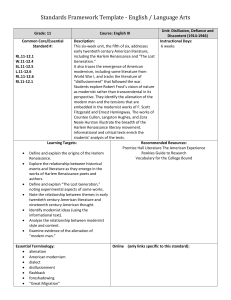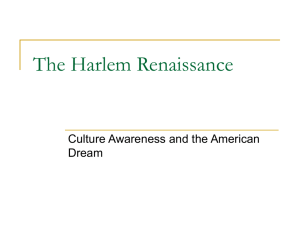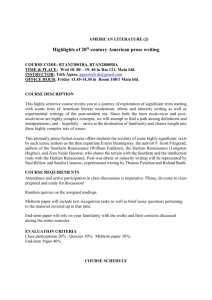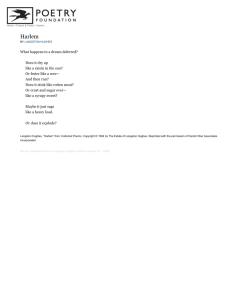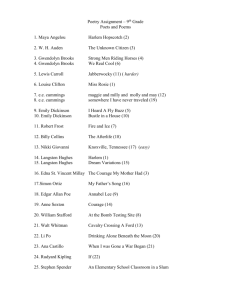eng_3_unit_5
advertisement
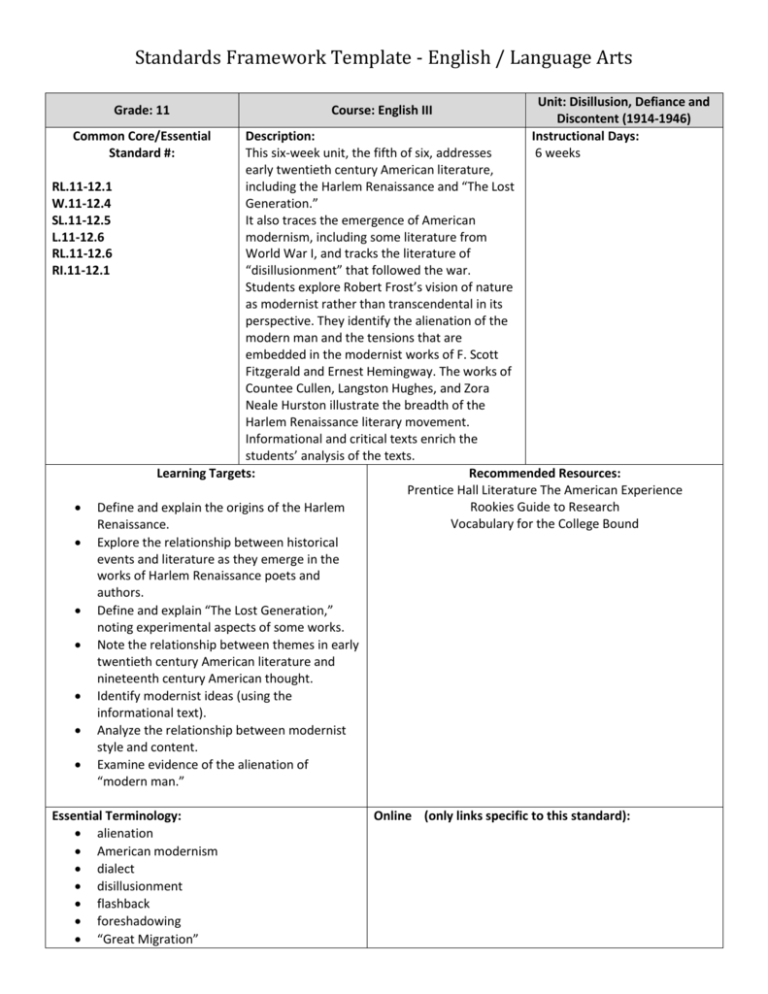
Standards Framework Template - English / Language Arts Grade: 11 Common Core/Essential Standard #: Course: English III Unit: Disillusion, Defiance and Discontent (1914-1946) Instructional Days: 6 weeks Description: This six-week unit, the fifth of six, addresses early twentieth century American literature, RL.11-12.1 including the Harlem Renaissance and “The Lost W.11-12.4 Generation.” SL.11-12.5 It also traces the emergence of American L.11-12.6 modernism, including some literature from RL.11-12.6 World War I, and tracks the literature of RI.11-12.1 “disillusionment” that followed the war. Students explore Robert Frost’s vision of nature as modernist rather than transcendental in its perspective. They identify the alienation of the modern man and the tensions that are embedded in the modernist works of F. Scott Fitzgerald and Ernest Hemingway. The works of Countee Cullen, Langston Hughes, and Zora Neale Hurston illustrate the breadth of the Harlem Renaissance literary movement. Informational and critical texts enrich the students’ analysis of the texts. Learning Targets: Recommended Resources: Prentice Hall Literature The American Experience Rookies Guide to Research Define and explain the origins of the Harlem Vocabulary for the College Bound Renaissance. Explore the relationship between historical events and literature as they emerge in the works of Harlem Renaissance poets and authors. Define and explain “The Lost Generation,” noting experimental aspects of some works. Note the relationship between themes in early twentieth century American literature and nineteenth century American thought. Identify modernist ideas (using the informational text). Analyze the relationship between modernist style and content. Examine evidence of the alienation of “modern man.” Essential Terminology: alienation American modernism dialect disillusionment flashback foreshadowing “Great Migration” Online (only links specific to this standard): Standards Framework Template - English / Language Arts Harlem Renaissance industrialization interior monologue The Lost Generation motif stream of consciousness villanelle Essential Readings: Poems “Tableau” (Countee Cullen) “Yet Do I Marvel” (Countee Cullen) “Richard Cory” (E.A. Robinson) “The House on the Hill” (E.A. Robinson) “The Negro Speaks of Rivers” (Langston Hughes) “Mother to Son” (Langston Hughes) “Harlem” (Langston Hughes) “The Death of the Hired Man” (Robert Frost) “Birches” (Robert Frost) “The Road Not Taken” (Robert Frost) “The Love Song of J. Alfred Prufrock” (T.S. Eliot) “Poetry” (Marianne Moore) The Pisan Cantos (Ezra Pound) (selections) “Domination of Black” (Wallace Stevens) “A High-Toned Old Christian Woman” (Wallace Stevens) “Conscientious Objector” (Edna St Vincent Millay) “In the Dordogne” (John Peale Bishop) “Grass” (Carl Sandburg) “The Silent Slain” (Archibald MacLeish) Short Stories “A Rose for Emily” (William Faulkner) “Hills Like White Elephants” (Ernest Hemingway) “The Snows of Kilimanjaro” (Ernest Hemingway) “A Clean, Well-Lighted Place” (Ernest Hemingway) Novels Their Eyes Were Watching God (Zora Neale Hurston) The Great Gatsby (F. Scott Fitzgerald) As I Lay Dying (William Faulkner) A Farewell to Arms (Ernest Hemingway) The Pearl (John Steinbeck) Of Mice and Men (John Steinbeck) Winesburg, Ohio (Sherwood Anderson) (selections) Plays The Piano Lesson (August Wilson) Speeches Standards Framework Template - English / Language Arts Black Elk Speaks (Black Elk, as told through John G. Neihardt) (selections) “The Solitude of Self” (Elizabeth Cady Stanton) (February 20, 1892) “Freedom” (White) “The Spirit of Liberty” speech at “I Am an American Day” (1944) (Learned Hand) Essays “If Black English Isn’t a Language, Then Tell Me, What Is?” (James Baldwin) Art Marsden Hartley, Mount Katahdin, Maine (1942) Georgia O’Keefe, Ram’s Head, Blue Morning Glory (1938) Alfred Stieglitz, From the Back Window, 291 (1915) Jacob Lawrence, War Series: The Letter (1946) Charles Sheeler, Criss-Crossed Conveyors, River Rouge Plant, Ford Motor Company (1927) Stuart Davis, Owh! In San Pao (1951) Charles Demuth, My Egypt (1927) Arthur Dove, Goat (1934) Imogen Cunningham, Calla (1929) Shakespeare: Macbeth Essential Question: How are the turmoil and hardships Americans were facing reflected in the literature of this period? What is Modernism? What is Imagism? What is the Harlem Renaissance? Activating Strategy: KWL charts Anticipation guides Post it notes Suggested Instructional Tasks: Cornell notes on tenets of Modernism Think-alouds with Modernist poetry In-class writing time to draft argumentative essay related to tenets of Modernism exemplified in various works Students write “Theme for English III” in response to Hughes’ “Theme for English B” Literacy Component: Reading RL.11-12.1: Cite strong and thorough textual evidence to support analysis of what the text says explicitly as well as inferences drawn from the text, including determining where the Writing W.11-12.4: Produce clear and coherent writing in which the development, organization, and style are appropriate to task, purpose, and audience. (Grade-specific expectations for writing types are defined in Listening & Speaking SL.11-12.5: Make strategic use of digital media (e.g., textual, graphical, audio, visual, and interactive elements) in presentations to enhance understanding of findings, reasoning, and evidence and to add interest. Language L.11-12.6: Acquire and use accurately general academic and domainspecific words and phrases, sufficient for reading, writing, speaking, and listening at the college and career readiness level; demonstrate independence Standards Framework Template - English / Language Arts standards 1–3 above.) text leaves matters uncertain. RL.11-12.6: Determine an author’s point of view or purpose in a text in which the rhetoric is particularly effective, analyzing how style and content contribute to the power, persuasiveness, or beauty of the text. RI.11-12.1: Cite strong and thorough textual evidence to support analysis of what the text says explicitly as well as inferences drawn from the text, including determining where the text leaves matters uncertain. in gathering vocabulary knowledge when considering a word or phrase important to comprehension or expression. Summarizing Strategy: KWL Exit tickets (3-2-1) GIST Support for Differentiation: ELL EC AIG After reading Eliot’s “The Waste Land” and John Beer’s “The Waste Land,” students can write their own version. Sample Formative Assessment (aligned to Learning Target):
